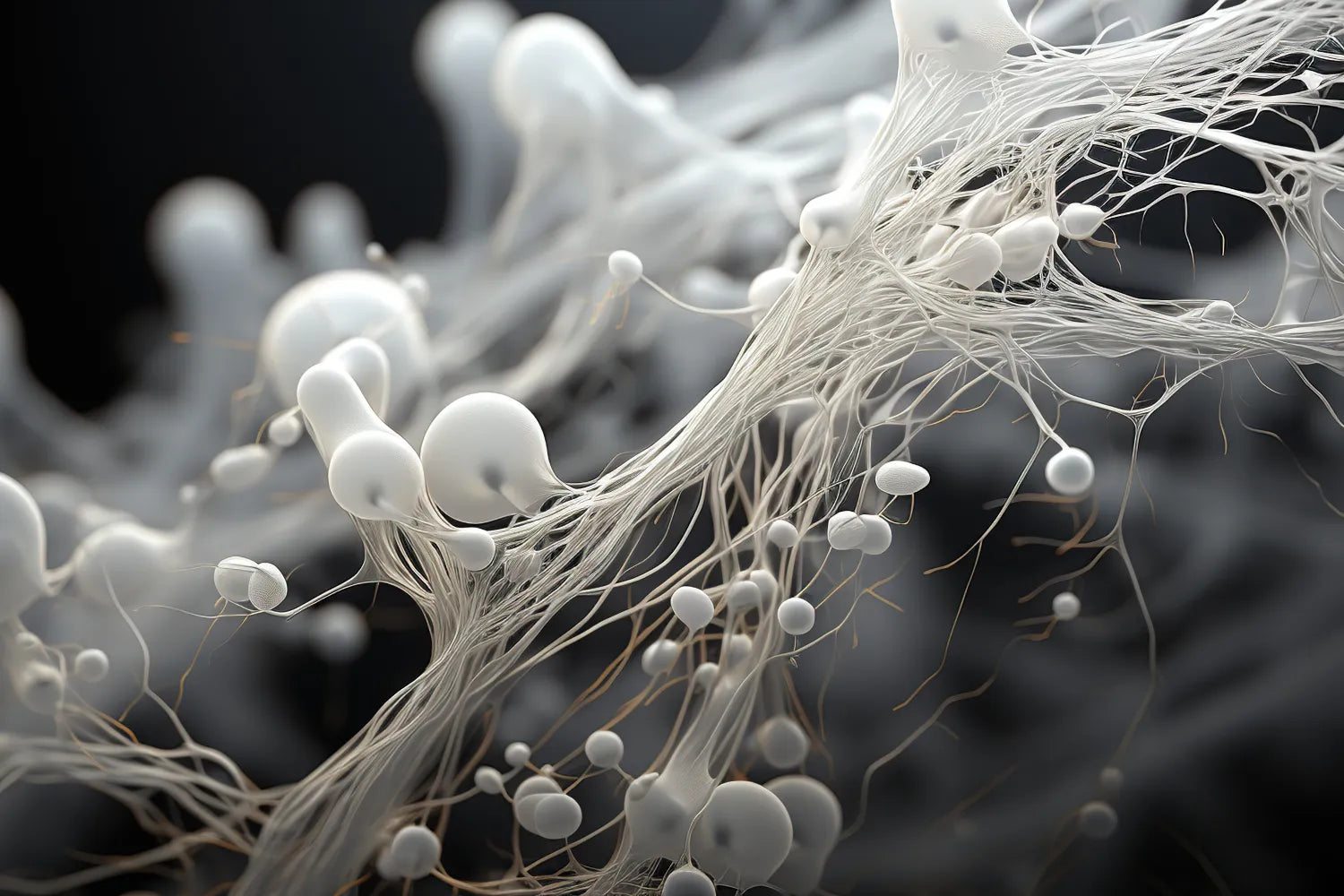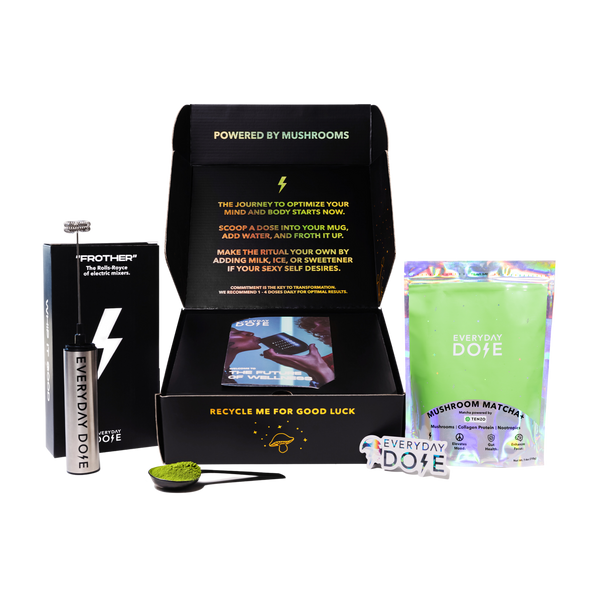Mycelium Growth Stages: All About Mushroom Life Cycles

Mushrooms are pretty fascinating when you think about it. They look kind of like plants, grow out of the ground like plants, and many people even think of them as plants — however, they’re actually just one part of a larger fungus.
Mushrooms have two main parts: the mycelium and the fruiting body. Read on to learn more about the parts of a mushroom, the growth stages of mushrooms, and when to harvest them.
What Is Mycelium?
Even though a mushroom isn’t a plant, it can be helpful to think of it in the same terms as a plant. Mycelium is similar to the roots of a plant.
It extends far beyond the surface of the soil (or whatever the mushroom is growing on) and branches out in long strands, just like roots. These individual strands are a fraction of the width of human hair and sometimes aren’t even visible to the naked eye.
Mycelium also has a function similar to that of roots. It reaches far and wide looking for nutrients and eventually, it uses these nutrients to produce a fruiting body.
What Is a Fruiting Body?
If mycelium is like the roots of a plant, then a fruiting body is like a flower. The fruiting body of a mushroom is what most people mean when they talk about mushrooms, and it’s the part that’s visible above the ground.
Fruiting bodies are generally made up of three main parts. These include:
- The Stalk: A cylinder made of densely packed mycelium that supports the mushroom cap.
- The Cap: The round top that gives mushrooms their distinctive shapes.
- The Gills: These typically grow under the cap and contain spores.
However, there are some mushrooms that don’t have any of these parts. For instance, lion’s mane mushrooms don’t have stalks or gills, and their caps don’t look anything like the mushroom caps you might be used to seeing.
Fruiting bodies have one major difference from plant flowers. While the above-ground parts of plants can be visible year-round, fruiting bodies are only grown under the right conditions. A fungal organism can go years without producing a visible fruiting body.
What Are the Growth Stages of a Mushroom?
Now that we’ve had a crash course in mushroom terminology, it’s time to dig in a little deeper. There are four main stages of mushroom development: Spore germination, colonization, fruiting, and sporulation.
1. Spore Germination
Mushrooms don’t grow from seeds. Instead, they grow from spores. The main difference between the two is that seeds have many cells and contain everything needed for the plant inside to grow, while spores are made of only one cell and don’t contain any nutrients.
The first stage of mushroom development is when a mushroom spore settles into its new home. If the conditions are right, a single strand of mycelium will erupt from the spore and begin looking for nutrients. Usually, the conditions needed to help a mushroom germinate are humidity and warm temperatures.
2. Colonization
As the mycelium grows, it begins to form more strands of hyphae. These hyphae can combine to form larger strands, which continue spreading throughout the substrate to gather nutrients.
“Substrate” is just a fancy term that refers to whatever a mushroom has decided to grow in. This could be dirt, straw, trees, or even grain. As the mushroom colonizes the substrate, it breaks down matter, slowly turning the substrate into dirt.
The more substrate the mushroom can capture, the more nutrients it can take in. Some mushrooms take over small patches of dirt, while others can cover acres of land, expanding until they encounter another mushroom.
3. Fruiting
When nutrients and environment are just right, mushrooms produce fruiting bodies. The ideal conditions depend on the type of mushroom, but they usually involve high humidity and a minor drop in temperature. This is why mushrooms are more common in the autumn, once temperatures start to cool down.
Fruiting bodies grow in four stages:
- Stage One: In this stage, individual hyphae come together to form a knot. This is called a hyphal knot and will eventually become the mushroom.
- Stage Two: Primordial bumps form on the knots, looking almost like small knots or balls beneath the surface.
- Stage Three: These bumps will eventually form very tiny mushrooms called pins.
- Stage Four: If the conditions stay ideal, these pins will grow over a few days to a few weeks and eventually become the larger mushrooms you’re used to seeing.
4. Sporulation
As the fruiting bodies mature, gills or pores form on the underside of their caps (if they have them). Some mushrooms have a ring around the underside of their caps that protects them while they’re still in the pin stage of development.
Once the fruiting bodies are mature, the gills are exposed and the spores are released. Sometimes, mushrooms release so many spores that they can look like mist or fog. You may even see a dust-like collection of spores around the ground beside the mushroom.
These spores are so small that they can be carried long distances in the wind. They can even drift over entire oceans and continents.
When Should Mushrooms Be Harvested?
When you introduce mycelium to a substrate, it can take over pretty quickly. However, it won’t produce a fruiting body until the conditions are just right.
Many companies harvest medicinal mushrooms before they even form fruiting bodies, using the myceliated biomass itself to create supplements. This is definitely easier and more efficient, but it poses a few issues.
For instance, mycelium is less nutritionally dense than fruiting bodies, and they contain fewer medicinal compounds. On top of that, mycelium is often grown on a grain substrate.
Because individual hyphae are so thin, it’s impossible to separate them from their substrate. This means that the grain inevitably becomes part of the extract. In fact, many products made with myceliated grain are actually mostly made of starch and are seriously lacking in beneficial compounds.
That’s why we use 100 percent mushroom fruiting bodies in our mushroom blends. Our mushrooms are wild-harvested and grown on trees, as opposed to being grown in a lab on grain.
The Bottom Line
Most people could probably identify a mushroom if they saw one, but mushrooms have so much more going on underneath the surface — literally! While the mushroom fruiting body is what most people are used to seeing, the root-like mycelium is the heart of the mushroom. However, it’s the fruiting body that contains the most beneficial compounds.
At Everyday Dose, we live and breathe mushrooms. We use mushrooms like chaga and lion’s mane that are grown as naturally as possible. This way, we know they’re as rich in beneficial compounds as they can be. To try the benefits (and delicious flavors) or our mushroom blends yourself, give our Mushroom Coffee+ a try today!
Sources:
Bearded Tooth | Missouri Department of Conservation
Mycelium: Exploring the hidden dimension of fungi | Kew








